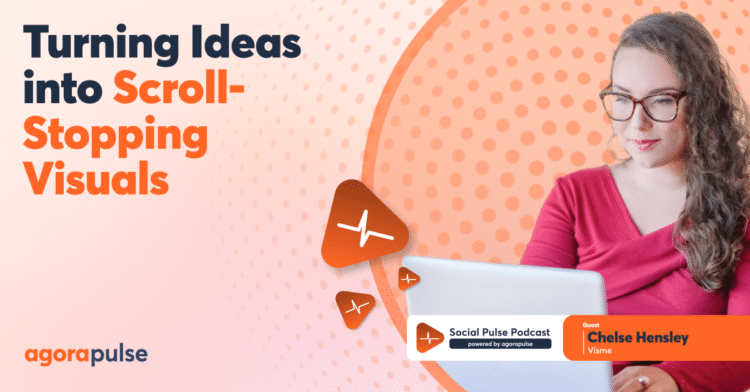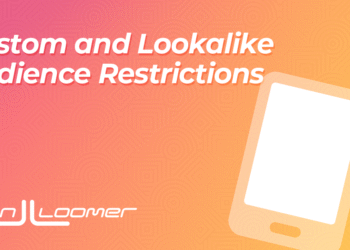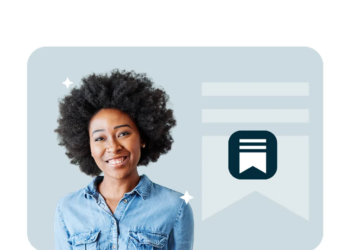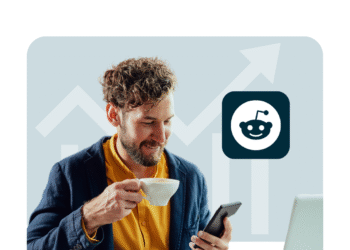Are your social media ideas getting lost in translation when it comes to visual execution? You spend hours crafting the perfect strategy, developing messaging that hits all the right notes, but when it comes time to create the actual content, something gets lost along the way. Your posts don’t have the visual punch they need to stop the scroll, your carefully planned campaigns fall flat, and you’re left wondering why your brilliant ideas aren’t converting into the engagement you know they deserve. Sound familiar? You’re not alone in this struggle.
That’s exactly what our guest today is here to help with. Meet Chelse Hensley, Social Media Strategist and Influencer Manager at Visme, where she manages the social footprint for a brand with over 35 million users. Chelse is a master of zero-click marketing and specializes in helping SaaS brands show up, stand out, and stay top-of-mind by turning strategic concepts into magnetic visual content that’s impossible to ignore. With her knack for punchy content, platform-native strategy, and deep love for storytelling, she’s built a reputation for creating scroll-stopping visuals that transform passive fans into active communities.
Social Pulse Podcast host Mike Allton asked Chelse Hensley about:
🧡 Strategic Visual Translation – How to bridge the gap between brilliant social media strategy and compelling visual execution that stops the scroll.
🧡 Platform-Native Design Thinking – Why one-size-fits-all visuals fail and how to create content that feels native to each social platform while maintaining brand consistency.
🧡 Scaling Creative Output – How busy social media professionals can systematically turn strategic concepts into high-quality visual content without burning out or compromising authenticity.
Learn more about Chelse Hensley
Resources & Brands mentioned in this episode

Full Transcript
(lightly edited)
I’d love it if you could start by just telling us about your role at Visme and what it means to manage a platform in a brand with so many users.
Chelse Hensley: Yeah, so many social media managers can probably relate to me. I am a woman of many hats, so while my role is social media director, I also conceptualize and create campaigns that we will run on social media, but there are also multiple other facets to that.
It’s the community that we build. We have a private community of super users. It is influencer management. It is brand partnerships with other B2B companies to think of creative ways to elevate both of our reach without necessarily spending the ad dollars on it. It’s a lot of facets, but every day is a new, exciting challenge, and I love working at Visme and helping to grow not only the social, but also helping our 35 million users.
I like to say social is the boots on the ground. And so, where’s the first place someone’s going to go to if they have a question? That’s social media, so having all of the information that’s super informative for them when they need it is one of my top priorities.
Mike Allton: Love it. Now, I mentioned zero-click marketing in the intro, something you’re known for. I follow Amanda Natividad from SparkToro on social media. I love that she talks about it so much.
Chelse Hensley: Yeah, I love the team SparkToro, we’ve actually done a few partnerships together as well, but I think that basically the way that people are consuming social media now in the year 2025, is they don’t want to leave the platform. And so we have to adjust expectations of how users are going to consume our content.
And so that’s providing value and you. Whether you’re informing, entertaining, or you want to drive a sales lead, whatever your goal is, it’s how can you lower the barrier of entry so much to make that happen without them leaving the platform? Because more often than not, they won’t.
And so I think that’s the beauty of providing that type of valuable content on social media.
Mike Allton: Got it. And I agree. I think that’s definitely something I’ve seen over the years. It’s. Something, sadly, I’m moving towards myself. I’m a blocker. I love writing. I love getting people to go read my blog, but that’s not really what social media is for these days.
Chelse Hensley: I do think that’s, that is a big mistake, and I think that it’s not a wrong mistake to assume because, think of the years, I was in the forefront of when social media became a job and its role for companies.
This was 2013, we’ll even say pre-pandemic. You used links, and you still had managers and bosses who said, We want to drive to X Channel. That’s your goal as a social media manager is you need to drive them to the landing page, the website, what have you. And I think that is a big hurdle that social media managers now are starting to understand and not push back with their leaders, but help them see the light.
Another big challenge is, as you mentioned, connecting your visuals to your goal on social media. And Visme is a design platform. We are very design-forward thinkers, so I try to prioritize design and feel, and brand into each and every post. Now, I want to clarify that doesn’t necessarily mean making it look perfect.
I think we can all tinker with perfection in a graphic or a video, but ultimately, it needs to get out to work. So whatever is the lowest barrier of entry to get that published is the way you should go.
Walk us through your process. How do you actually go from the strategic concepts that we’ve been talking about at a high level to a piece of actual content that stops that scroll?
Chelse Hensley: Yeah, and this is the same process, whether you have a design on your staff or so many social media managers. Are the designers on staff, and they’re the ones making the content? And that’s why it is so important to use a tool like Visme where you are creating the content. Even if you’re not a graphic designer, you don’t have to use super heavy tools.
So my first step is to understand the concept or the goal. Like I said, if it is to score a lead to grab attention for an engagement, is it to watch a video? Is it to swipe on a carousel? So having that stand out within the first instant, someone sees it on the scroll, oftentimes, that does mean it can look a little messy.
So you have to think of the platform on Instagram, right? So we are used to seeing high aesthetics on Instagram. However, that does not translate to other platforms as easily, such as TikTok. So, when TikTok was coming on board, I made the mistake of saying, Oh, I can repurpose my Instagram Reels on TikTok.
They’re similar, right? Wrong. You have to think of how users are consuming that platform. So I ended up making TikTok a little bit messier, a little more authentic. I didn’t edit as much, I didn’t put in so many filters, or I didn’t use third-party apps to add text, so I edited natively. I think [for] a lot of social media managers, yes, it’s so tough to format your posts individually for every platform, but it does make a difference.
Mike Allton: It’s a challenge to do the work. And then the, just the simple fact that it means spending extra time devoted to a particular platform or a specific piece of content.
How does Visme help with some of those challenges?
Chelse Hensley: In the tool, we have a lot of features like resizing.
We also have an AI designer that you can put a prompt in and say, I want this size, and then it spits it out. But I think it goes beyond that. I think that, like I said earlier. I kind of feel comfortable in the messy middle of perfection and publication. That’s a good tagline.
I love that, where putting it out is the most important thing. So while you do want to make sure your brand looks professional and clean and you have clarity in your message, using platforms that are quick and easy to create content is going to be more beneficial than perhaps for teams who don’t have a lot of people, you don’t have a videographer, you don’t have a graphic designer, versus outsourcing that, and then you might miss a trend because the turnaround time was so long.
I’m a big believer in just getting it out there.
Chelse Hensley: It’s funny, I used to be really trend heavy, and I found that with our niche, with a B2B, a SaaS, a more enterprise-driven company, yes, it can work.
If you have someone dedicated, I don’t want to say 24/7, but if you have someone on the feed all day who can snap up those trends, one of the limitations as a social media manager is. You might have trends happening while you are deep in the thick of looking at a spreadsheet, or you are in YouTube analytics and you’re not picking up these things.
And I found that, Visme in particular, our audience wasn’t visiting our socials for trends, and so I took a step back and said, How can I leverage social not to go viral, but to provide that solution that someone’s looking for. And so we don’t participate in trends as much, but I love it when teams do. And you can tell when a team is a team and not just one, when they do participate in trends I hats off to them.
Mike Allton: Chelse, you talked about manipulating visual content for different kinds of platforms. You talked about just getting it out there, even if it’s sometimes a little bit messy.
I’m wondering how you maintain brand consistency in this mess, get it shipped, hit all the different platforms, and the environment?
Chelse Hensley: Having a brand guide is really your savior in this instance. Making sure that even if you are the one putting it together, you want to have the consistency, and I call it feel over format. If you are a team of one, you want to make sure that you create a brand guide that has, what are the elements you’re using.
Are you using gradients? Are you using specific icons or illustrations? Obviously, what’s your collar palette? What is your main font, and then your sub font? Sticking to those allows an easy way to manufacture content without going to the drawing board every single time. You can create a brand guide in Visme; it has saved me so much time.
I think that’s really the key piece. And if you don’t have one, sit down with someone on your team and create one.
Mike Allton: I love that. And you make a strong point that it’s not just about the fonts. And the colors are so much more in-depth than that.
Tell me a little bit more about the brand guide in Visme. What are the elements that you can incorporate in there?
Chelse Hensley: What’s really fun in Visme is you can take your URL, your website URL, and just copy and paste it into our brand wizard, which we call it. And the brand Wizard will pull all of your logo, your fonts, basically every piece of media, images from your website, and then the AI design Generator will conceptualize these as some proposals.
These are some presentations, social media graphics based on what you already have on your website. So it’s seamless to use. I can’t recommend it enough, especially if you are in need of creating something fast and in a hurry.
Mike Allton: Okay? So for those of you listening, if you don’t already have a brand guide.
That’s where you start. Visme AI generator. Now, one of the things I mentioned at the outset that I just love is how much you love storytelling as a chief storyteller. It’s a passion of mine.
What role does it play in your visual content strategy, and how do you weave narrative into your different designs?
Chelse Hensley: Yeah, so I think it goes into problems and solutions. So we have found on our social media that people aren’t necessarily. So let’s take it back to skits. We were talking about trends initially, and within those trends, we said skits are working on TikTok. Let’s let that form our strategy, ’cause that is, in a sense, a version of storytelling.
We found that for our audience, every audience is different, which was not landing. So take it back to the drawing board. What is our version of storytelling and its problem and solution? So in a sense, to get our 35 million users. Instead of always going to support if there’s an issue, what are ways that we can provide a narrative using the existing content we have?
For example, we’ve really built out our tutorial database. These are handcrafted; these are really like formative short YouTube videos that are on our YouTube. Subscribe to us, the Visme app on YouTube, which provides a solution, and that’s our version of storytelling.
So, what I will do as an example of that is take a long-form YouTube video that we’ve published. Maybe it’s 10 minutes long, and I put it in a tool I use called Latte Social. I pay $5 a month for it, give them a shout out, and they will clip it up for me in several different formats. And so that’s our version of storytelling is just instantly providing solutions without someone having to sift through the muck.
And I think on social media, there is a lot of muck, so it goes back to that zero click marketing philosophy of what is the lowest barrier of entry that you can provide, whether it’s storytelling or informative to your audience as much as possible.
Mike Allton: Love that. There’s such a huge point there that for folks of you listening, your stories don’t have to look like everybody else’s. You can define what storytelling means for you and your brand, or even across different channels. Now, I also know that a lot of the folks listening are probably going to start to feel overwhelmed by just the entire visual creation process. ‘Cause I think we triggered ’em a little bit earlier when we said, No, sorry, your TikToks can’t be your Reels repurposed.
What’s your advice to them to help them scale their content creation?
Chelse Hensley: I don’t want to say that’s every brand’s rule. But in order to scale, I think there’s power in batch working, and every blog on the internet will tell you. Batch work.
But there is value in that. And so, using something like the AI resize tool in Visme, or whatever tool you use, a lot of platforms have that same tool now, where you can put in a piece of content, and it will generate different formats. Just make sure that you don’t go from platform to publication without putting your soul into the post.
And I know that sounds silly, but. I’ve been a social media manager for over 10 years now. I don’t want to lose the soul of what it’s supposed to be, so give it an overview. Make sure it’s, it has the feel and clarity that you want from your post, and it doesn’t feel robotic.
I think that’s also another thing is with the growth of all these AI tools, every post may start to look the same. So even though you’re reformatting them, just make sure you put the soul back into it.
Mike Allton: I love that. Put the soul into it. That’s fantastic. So we’re creating a lot of different content for a lot of different channels, but we’re also focusing on the zero-click marketing recruiting content that doesn’t have links back to our website.
Chelse Hensley: That really is something that. Every brand is going to be unique, and so for us, we tested, when I came onto Visme, we tested a lot of things. Like I mentioned earlier, some of them worked, some of them didn’t. So I think that knowing what your ultimate goal is, for example, someone may just want to know how many times we’ve all heard from someone. We want to go viral. We want to go viral.
And you have to have that difficult conversation. But if that is your goal, you’re going to create content that is more likely to go viral, for example, maybe something that is a skit.
However, if your ultimate goal within your brand is to, let’s say, drive enterprise leads, going viral to an audience on social media is not necessarily, is not the cause and effect in most opportunities. So knowing what your goal is and positioning yourself. In that landscape is the way to success.
And whether that is we like to use brand lift, so I would rather have someone look at my content for four seconds and retain it, versus they’re going to click on something, but then they exit out immediately, and they don’t retain any of the information. So take a look at what your ultimate marketing goals are not, and I think that this is a really important point.
Use social media, not as an island where you are so focused on social media metrics. Take a look from a larger perspective and say, How can I leverage social media for my ultimate marketing goals? And I think that’s where you can find what metrics are important for you.
Mike Allton: You know what a hard conversation is, don’t you? Gosh. It’s like you’re newly married and all of a sudden you realize your spouse doesn’t want kids, but you do. And now you’ve have to have this conversation to figure out how do we navigate this completely opposed viewpoint, because particularly when we’re talking about B2B SaaS, the capability of a B2B SaaS to go viral just isn’t there for the most part.. ‘Cause virality is based on mainstream consumers participating in the content. And that shouldn’t be who you’re talking to with your content. I would imagine that as a B2B space market.
Chelse Hensley: A lot of those companies that do go viral. So we’re talking, I think Hootsuite is probably the biggest, shout out to Hootsuite.
But these are legacy tools that got on the jump in the mid-2010s. And so I think we have to have a real conversation with ourselves as brands, as saying. Maybe we didn’t start social media marketing as early as we should, but now we have to adapt, and we’re not a legacy brand, so we have to have our own goals in mind and not try to compete with these legacy brands.
Mike Allton: A hundred percent agreed on that. So we’ve talked about trends, we’ve talked about understanding best practices to a large degree on the various social networks.
Chelse Hensley: Honestly, I don’t think there is keeping up. I think that treading water. But as far as tools go, I personally am very, I’ve been very vocal about raw short-form problem solution video. And so for me, and
Visme, that is, YouTube Shorts and TikTok. And one of the tools that I’ve really found that is very useful for me is CapCut. I don’t have to edit on my desktop. I can do it for my app. And so, as a social media manager, the ability to edit on mobile is huge.
Visme also has a mobile app that makes editing super easy while you’re on the go. But for TikTok, and like I said, YouTube and Instagram Reels. I think that CapCut is great. And one of the good things about that tool is that it will provide templates of trends. So they have, I think, a top 10 list of, here are the top 10 trending meme formats, and then you can plug and go, yeah, I’m a big fan of CapCut free advertising here for them.
Mike Allton: I love how much you’re pushing back on a lot of traditional mindsets when it comes to social media marketing. So I appreciate you coming out here, ’cause I know folks are going to be maybe taken aback, maybe triggered a little bit, but certainly their minds are buzzing with ideas and questions.
If they’ve got more questions for you or they want to learn more about Visme, you’ll see where they should go.
Chelse Hensley: I would love for you to follow us on TikTok and YouTube. Our YouTube is very informative. We cover complex topics like how to create a marketing plan or design tutorials, and the foundations of typography.
And we also cover not only tutorials of the tool, but Brand concepts. What does it mean to create a brand identity? It is extremely useful. And follow us on TikTok as well for kind of the short-form versions of that. We are using the @Visme app on all channels. Come follow us. Come follow me.
Mike Allton: Fantastic. Thank you so much, Chelse. Thanks to all of you for listening. We will, of course, have all of Chelse’s and Visme’s links in the show notes below. That’s all the time we’ve got for today, friends.
Thank you for reading this transcript of the episode of the Social Pulse Podcast. But don’t forget to find the Social Pulse Podcast on Apple and drop me a review. Let me know what you thought of this episode, and be sure to join our exclusive community on Facebook, the Social Pulse Community, where you’ll be able to network with fantastic guests like Chelse, as well as thousands of other social media professionals in the industry.
Until next time.






![How Search Engines Work [Explained]](https://mgrowtech.com/wp-content/uploads/2025/08/how-search-engines-work-sm-75x75.png)









